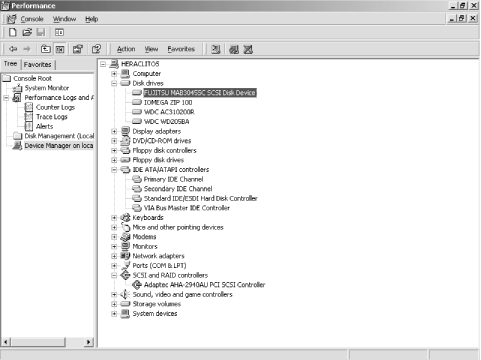Disk Interfaces
So far, we have discussed the architecture of disks and their impact on the performance of the I/O subsystem, as well as the I/O buses that are available. In order for the data to be processed by an application, it needs to be transferred from the disk device to the I/O bus over an interface. In this section, we describe in detail the two most popular interfaces for attaching disks to a Windows 2000 machine—the IDE and SCSI disk interfaces—and briefly discuss some of the more advanced interfaces that are starting to appear in the market.
The Device Manager snap-in in the Windows 2000 management console classifies the devices installed on a system by interface type. Figure 8-11 shows the main screen that the device manager presents, with the disk drives, IDE/ATAPI controllers, and SCSI and RAID controllers entries expanded in the tree view. Using this view, you can determine which devices are recognized by the system, how they are connected to the system, and you can change their advanced settings.

Figure 8-11. List of devices by interface type by the Device Manager snap-in
What Is an Interface?
Before looking into the operation and functionality of the IDE and SCSI disk interfaces, we first examine the services that must be provided by an interface. A hard disk consists of multiple components that ultimately provide persistent storage and transfer of data between a ...
Get Windows 2000 Performance Guide now with the O’Reilly learning platform.
O’Reilly members experience books, live events, courses curated by job role, and more from O’Reilly and nearly 200 top publishers.

